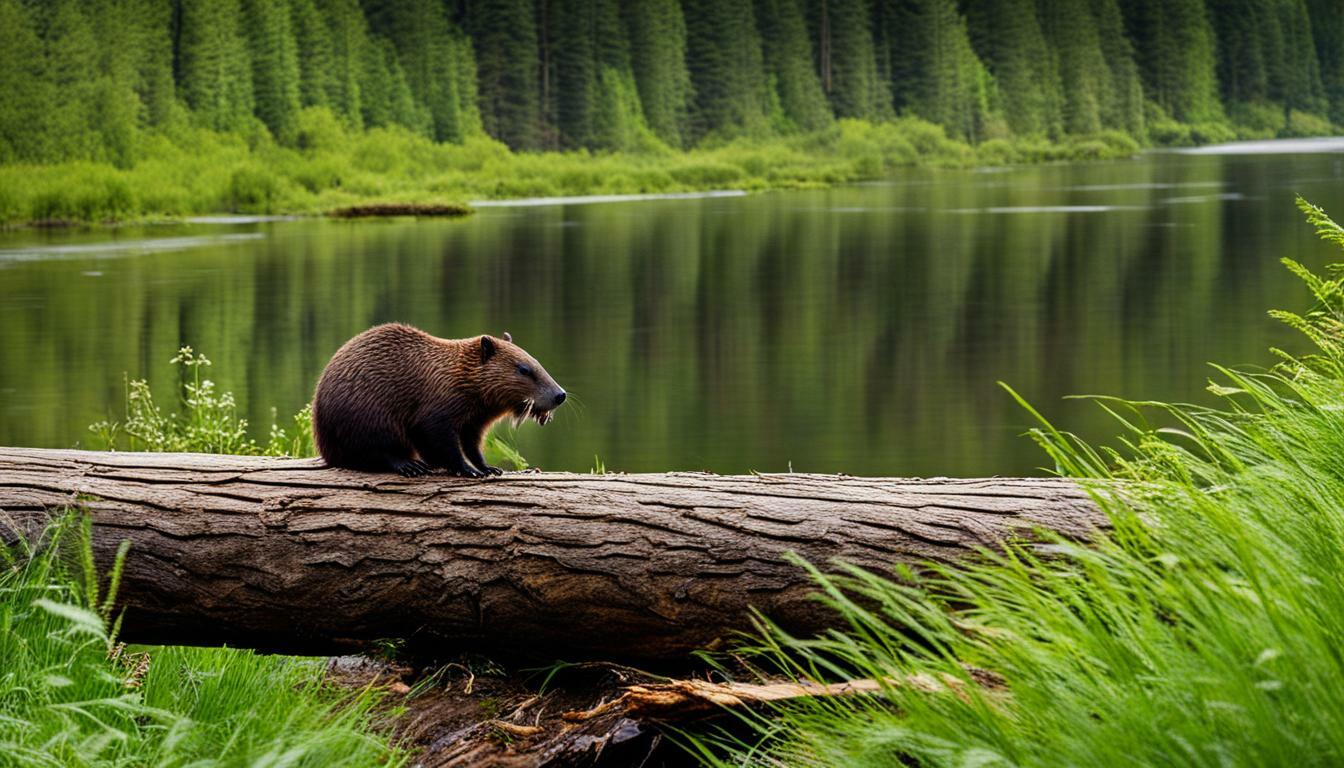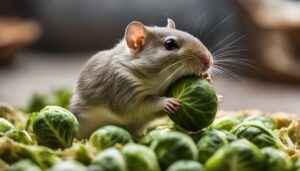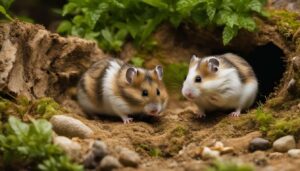Beavers are often associated with wood due to their impressive ability to build dams and lodges, but do they actually eat wood? Contrary to popular belief, beavers do not consume wood in the traditional sense. Instead, they eat the inner bark of trees, specifically the cambium layer, and the softer wood just beneath the bark. This behavior serves the important purpose of filing down their continuously growing incisor teeth. Let’s delve deeper into the fascinating diet and wood-eating habits of beavers.
Key Takeaways:
- Beavers do not eat wood, but instead consume the inner bark and softer wood for dental maintenance.
- They primarily eat a variety of trees such as willow, aspen, cottonwood, maple, birch, oak, alder, and apple trees.
- Beavers also consume woody stems, grasses, roots, vines, shrubs, leaves, and aquatic plants.
- They use the wood they cut to build lodges and dams, which provide shelter and protection.
- For winter preparation, beavers store food, such as branches, beneath their lodges on the muddy pond floor.
Understanding the Beaver Diet
To understand whether beavers truly eat wood, it is important to explore their overall diet and consumption habits. While it may seem that these industrious creatures devour wood, they actually focus on a specific part of trees – the inner bark, also known as the cambium layer. Beavers use their remarkable gnawing and chewing behavior to file down their continuously growing incisor teeth, and in the process, they consume the soft wood just beneath the bark.
Beavers primarily have a taste for a variety of tree species, including willow, aspen, cottonwood, maple, birch, oak, alder, and even apple trees. However, their diet extends beyond trees. Beavers also consume other plant material such as woody stems, grasses, roots, vines, shrubs, leaves, and even aquatic plants. Their diverse diet showcases the adaptability and resourcefulness of these fascinating creatures.
Utilizing the wood they cut, beavers construct elaborate lodges and dams. These structures serve as both shelter and protection from predators. By skillfully utilizing their wood-chomping abilities, beavers transform their surroundings, shaping the landscape to suit their needs.
| Food | Examples |
|---|---|
| Tree Species | Willow, aspen, cottonwood, maple, birch, oak, alder, apple |
| Plant Material | Woody stems, grasses, roots, vines, shrubs, leaves, aquatic plants |
In preparation for the winter months, beavers diligently collect and store food. They stash branches, which serve as a vital food source, beneath their lodges on the muddy pond floor. This smart strategy ensures they have sustenance during the colder months when food may be scarce. Their ability to plan ahead and store food showcases their exceptional survival instincts.
With their unique diet and distinct behaviors, beavers play a crucial role in shaping ecosystems. Their consumption of wood, specifically the inner bark, influences the health and growth of tree populations. By creating lodges and dams, they create new habitats, providing shelter and opportunities for other wildlife. Beavers are true architects of their surroundings, making a significant impact on the natural world.
The Role of Wood in a Beaver’s Diet
While beavers don’t technically eat wood, it plays a crucial role in their diet and survival. The inner bark of trees, specifically the cambium layer, serves as their primary food source. Beavers are known for their gnawing and chewing behavior, which helps file down their continuously growing incisor teeth. They consume the softer wood just beneath the bark, providing them with essential nutrients and energy.
Beavers have a diverse diet that consists of various types of trees such as willow, aspen, cottonwood, maple, birch, oak, alder, and even apple trees. They also consume other woody vegetation like stems, grasses, roots, vines, shrubs, leaves, and aquatic plants. This diverse diet ensures that they obtain the necessary nutrients for their overall well-being.
The wood that beavers cut down serves multiple purposes in their lives. They use it to construct lodges and dams, which provide them with shelter and protection from predators. These structures are essential for their survival, as they create safe environments where beavers can live and raise their young.
| Beaver Feeding Habits | Wood Consumption by Beavers |
|---|---|
| Beavers consume the inner bark of trees, specifically the cambium layer. | Wood serves as the primary food source for beavers. |
| They also eat the softer wood just beneath the bark. | Beavers obtain essential nutrients and energy from consuming wood. |
| Beavers primarily eat a variety of trees such as willow, aspen, cottonwood, maple, birch, oak, alder, and apple trees. | Wood consumption by beavers is crucial for their survival and well-being. |
| They also consume woody stems, grasses, roots, vines, shrubs, leaves, and aquatic plants. | Beavers utilize the wood they cut to build lodges and dams, providing shelter and protection. |
In preparation for the winter months, beavers store food beneath their lodges on the muddy pond floor. This food stockpile, consisting of branches and other vegetation, ensures they have enough sustenance during the colder months when food sources are scarce.
Beavers’ wood consumption not only sustains their own lives but also contributes to the functioning of ecosystems. Their gnawing and felling of trees create openings in forests, allowing for new growth and increasing biodiversity. The dams they build also create wetland habitats, which support a variety of plant and animal species. Therefore, beavers play a crucial role in shaping and maintaining healthy ecosystems.
What Beavers Actually Consume
Beavers have a diverse diet, which includes more than just wood. They consume a variety of plant material, including the inner bark of trees. While it’s true that beavers use their gnawing and chewing behavior to file down their continuously growing incisor teeth, their wood consumption serves a purpose beyond just nutrition. By consuming the inner bark and softer wood just underneath the bark, beavers are able to meet their nutritional needs and maintain healthy teeth.
In addition to wood, beavers also consume a range of other plant material. They eat woody stems, grasses, roots, vines, shrubs, leaves, and even aquatic plants. This diversity in their diet allows beavers to adapt to different habitats and ensures that they obtain the necessary nutrients for survival. Moreover, beavers play a crucial role in shaping their ecosystems through their feeding habits.
When it comes to specific trees, beavers have their preferences. They particularly enjoy feasting on willow, aspen, cottonwood, maple, birch, oak, alder, and apple trees. These tree species provide a significant source of food for beavers, and their consumption can have an impact on local tree populations. It’s fascinating to see how beavers’ wood consumption contributes to the natural dynamics of their environment.
| Types of Plants Consumed by Beavers |
|---|
| Inner bark of trees |
| Softer wood beneath the bark |
| Woody stems |
| Grasses |
| Roots |
| Vines |
| Shrubs |
| Leaves |
| Aquatic plants |
Furthermore, beavers utilize the wood they cut to build impressive lodges and dams. These structures provide beavers with shelter and protection from predators. It’s also interesting to note that beavers store food for the winter months. They collect branches and store them beneath their lodges on the muddy pond floor. This strategic preparation ensures that beavers have access to food even when other resources become scarce during the colder months.
All in all, beavers have a fascinating diet that goes beyond just wood consumption. Their diverse food choices, including the inner bark of trees, woody stems, grasses, roots, vines, shrubs, leaves, and aquatic plants, contribute to their survival and their role in shaping ecosystems.
Beavers as Tree Lovers
Beavers have a strong affinity for certain tree species, such as willow, aspen, cottonwood, maple, birch, oak, alder, and even apple trees. These magnificent creatures play a crucial role in shaping their surrounding ecosystems through their choice of trees to consume. As they gnaw and chew on the bark and wood, they file down their continuously growing incisor teeth and enjoy a nutrient-rich meal.
Wood Preferences
When it comes to their tree preferences, beavers tend to favor willow, aspen, and cottonwood trees. The bark and softer wood just beneath the bark are the primary targets of their consumption. However, their diverse taste extends beyond these tree species. Beavers also appreciate the appeal of maple, birch, oak, alder, and even apple trees. This wide range of preferences ensures that they have an ample food source throughout their habitats.
Supplementary Food Choices
While trees are their primary food source, beavers also consume a variety of other vegetation. They feed on woody stems, grasses, roots, vines, shrubs, leaves, and aquatic plants. This diverse diet allows them to obtain the necessary nutrients and sustains their population, ensuring the balance of their ecosystems.
| Preferred Tree Species |
|---|
| Willow |
| Aspen |
| Cottonwood |
| Maple |
| Birch |
| Oak |
| Alder |
| Apple |
As these industrious creatures consume trees and other plant matter, they leave a significant impact on their environment. Their selective feeding habits contribute to the diversity and composition of their ecosystems, making beavers an essential element in the delicate balance of nature.
Building with Wood
Beavers are known for their exceptional woodworking skills, using the wood they cut to create elaborate lodges and dams. Their ability to manipulate their environment through their construction projects is truly remarkable.
When it comes to building lodges, beavers utilize the wood they cut to create a strong and secure structure. They carefully choose the appropriate materials, such as logs and branches, to construct the walls and the roof. These lodges serve as their homes, providing shelter and protection from predators. The interior of the lodge is spacious, with separate chambers for sleeping, raising young, and storing food.
In addition to lodges, beavers also construct dams using the wood they cut. These dams play a crucial role in creating and maintaining wetland habitats. By blocking streams and rivers, beavers create ponds that provide a variety of benefits. These ponds serve as a water source, allowing beavers to safely access their lodge and store food. They also help regulate water flow, preventing erosion and creating a diverse ecosystem that supports a wide range of plant and animal species.
To further reinforce their dams, beavers use a combination of wood, mud, and stones. The wood acts as a structural frame, while the mud and stones help stabilize the dam. This union of natural materials creates a durable construction that can withstand the force of flowing water.
| Beaver Building Materials | Uses |
|---|---|
| Wood | Structural frame for lodges and dams |
| Mud | Reinforces dams and seals gaps in lodges |
| Stones | Stabilizes dams and adds strength |
Storing Food for Winter
In preparation for the harsh winter months, beavers store food for survival, ensuring they have enough to sustain them. These industrious creatures carefully collect branches and other woody vegetation, which they stash beneath their lodges on the muddy pond floor. This storage system acts as a pantry for the beavers, providing a readily available food source during the cold winter when foraging becomes more challenging.
Beavers meticulously choose and cut branches from their preferred tree species, such as willow, aspen, cottonwood, maple, birch, oak, alder, and apple trees. They carry these branches in their mouths, swimming back to their lodges to deposit them. The branches are strategically placed under the water, anchored in the muddy pond floor. This not only keeps the food supply from freezing but also protects it from predators.
The beavers’ ability to store food for the winter is crucial for their survival. By accumulating a substantial supply of branches, they ensure they have enough sustenance until the arrival of spring when food becomes more abundant. This storage behavior showcases the beavers’ resourcefulness and adaptability, as they rely on their carefully organized food stash to endure the challenges of winter.
| Preferred Tree Species | Other Food Sources |
|---|---|
| Willow | Woody stems, roots, leaves |
| Aspen | Grasses, vines, shrubs |
| Cottonwood | Aquatic plants, grasses |
| Maple | Woody stems, grasses, roots |
| Birch | Leaves, woody stems, roots |
| Oak | Woody stems, grasses, roots, leaves |
| Alder | Woody stems, grasses, roots |
| Apple | Woody stems, grasses, roots, leaves |
Beavers’ resourcefulness extends beyond their feeding habits. By storing food during winter, they not only ensure their individual survival but also contribute to the resilience of their entire ecosystem. These storage behaviors influence the flow of nutrients and energy, making beavers valuable keystone species.
Beavers and Ecosystems
Beavers have a profound impact on their surrounding ecosystems, influencing the landscape through their wood-related activities. These industrious creatures shape their environment by cutting down trees and constructing intricate lodges and dams. As they gnaw through tree trunks, beavers create open spaces in forests, allowing sunlight to reach the forest floor and encouraging the growth of new vegetation.
By building dams across streams and rivers, beavers create wetlands and ponds that provide habitats for a variety of plant and animal species. These aquatic ecosystems support a diverse range of organisms, including fish, frogs, birds, and insects. The dams also help to regulate water flow, preventing erosion and reducing the risk of flooding downstream.
In addition to their engineering feats, beavers play a crucial role in nutrient cycling within their ecosystems. When they consume trees and other vegetation, they release nutrients back into the environment through their waste. This promotes the growth of plants and algae, which in turn support the entire food chain.
| Impacts | Effects |
|---|---|
| Creating open spaces in forests | Encourages the growth of new vegetation |
| Building dams | Creates wetlands and ponds, providing habitats and regulating water flow |
| Nutrient cycling | Releases nutrients into the environment, promoting plant and algae growth |
Beavers, with their unique wood-consuming habits, contribute significantly to the health and diversity of ecosystems. Their activities help to create a balanced and thriving environment for numerous plant and animal species. Without the presence of beavers, these ecosystems would lack the natural modifications that beavers provide, resulting in a potential loss of biodiversity and ecological function.
The Importance of Beavers’ Wood Consumption
Although beavers don’t eat wood as we typically think of it, their wood consumption serves vital purposes for their survival and ecosystem health. These industrious creatures have a unique diet that includes the inner bark of trees, particularly the cambium layer, which is a soft and nutritious layer found just underneath the bark. By consuming the cambium layer and softer wood, beavers not only fulfill their nutritional needs but also help maintain their constantly growing incisor teeth.
Beavers’ gnawing and chewing behavior serves the crucial purpose of filing down their teeth, which continually grow throughout their lives. This allows them to efficiently cut down trees and shape their environment. In addition to trees, beavers also consume a variety of other vegetation, including woody stems, grasses, roots, vines, shrubs, leaves, and even aquatic plants. This diverse diet enables beavers to adapt to different habitats and ensures their survival in various ecosystems.
| Types of Trees Consumed by Beavers |
|---|
| Willow |
| Aspen |
| Cottonwood |
| Maple |
| Birch |
| Oak |
| Alder |
| Apple |
Not only do beavers rely on wood consumption for their own survival, but they also play a crucial role in shaping ecosystems. Through their construction of lodges and dams using the wood they cut, beavers create habitats that provide shelter and protection for themselves and other species. These structures also help regulate water levels and improve the overall health of wetland ecosystems.
The Importance of Wood Storage
In preparation for winter, beavers engage in food storage practices by storing branches beneath their lodges on the muddy pond floor. This ensures a readily available food source during the colder months when foraging becomes challenging. By storing food in this manner, beavers exhibit their resourcefulness and ability to adapt to changing environmental conditions.
In conclusion, beavers may not eat wood in the same way humans consume food, but their wood consumption plays a critical role in their survival and the functioning of ecosystems. From their unique diet and teeth maintenance to the construction of lodges and dams, beavers demonstrate their remarkable ability to utilize wood in various ways. Their impact on shaping ecosystems and maintaining a delicate balance highlights the importance of understanding and appreciating these fascinating creatures.
Beavers vs. Wood-Eating Animals
While beavers are often associated with eating wood, their diet differs from animals that truly eat wood. Beavers do not consume wood in the traditional sense; instead, they feed on the inner bark of trees, specifically the cambium layer. This soft and nutritious layer lies just beneath the bark. Beavers also consume the softer wood found underneath the bark, using their gnawing and chewing behavior to file down their continuously growing incisor teeth.
Unlike animals that solely rely on wood as their primary food source, beavers have a diverse diet. They primarily eat a variety of tree species such as willow, aspen, cottonwood, maple, birch, oak, alder, and even apple trees. In addition to trees, beavers also consume other plant materials, including woody stems, grasses, roots, vines, shrubs, leaves, and aquatic plants. Their ability to utilize a wide range of vegetation contributes to their adaptability in different ecosystems.
The Differences in Wood Consumption
So, what sets beavers apart from other wood-eating animals? While some animals consume wood directly as a food source, beavers primarily use it for other purposes. They play a crucial role in shaping their environments by cutting down trees and using the wood to build lodges and dams. These structures provide shelter and protection from predators, as well as stabilize water levels and create wetland habitats.
In preparation for winter, beavers exhibit another unique behavior – they store food. Branches and other plant materials are stored beneath their lodges on the muddy pond floor. This strategy allows them to have a readily available food source during the colder months when foraging becomes more challenging.
In conclusion, while beavers are often associated with consuming wood, their diet is more diverse and complex. They primarily consume the inner bark of trees, as well as other plant materials found in their surroundings. Their wood consumption serves multiple purposes, from maintaining their teeth to constructing vital structures. Beavers are fascinating creatures with a diet that contributes to the overall health and functioning of their ecosystems.
| Fact | Detail |
|---|---|
| Primary food source | Inner bark of trees (cambium layer) |
| Other food sources | Woody stems, grasses, roots, vines, shrubs, leaves, aquatic plants |
| Wood utilization | Lodge and dam construction |
| Preferred tree species | Willow, aspen, cottonwood, maple, birch, oak, alder, apple |
| Food storage | Branches stored beneath lodges on muddy pond floor |
| Ecosystem contribution | Shaping environments through wood consumption and habitat construction |
Conclusion
Beavers may not actually eat wood, but their diet and wood-related activities are essential for their survival and ecosystem functioning. Contrary to popular belief, beavers consume the inner bark of trees, specifically the cambium layer, as well as the softer wood just beneath the bark. This behavior is not for sustenance but rather serves the purpose of filing down their continuously growing incisor teeth.
These industrious creatures primarily feed on a variety of trees, including willow, aspen, cottonwood, maple, birch, oak, alder, and even apple trees. In addition to trees, beavers also consume a wide range of other plant materials such as woody stems, grasses, roots, vines, shrubs, leaves, and aquatic plants.
Furthermore, beavers utilize the wood they cut to construct their distinctive lodges and dams. These structures provide shelter and protection from predators, as well as create suitable habitats for a variety of other species. In preparation for the harsh winter months, beavers store food, such as branches, beneath their lodges on the muddy pond floor.
By fulfilling their unique wood-related activities, beavers play a vital role in shaping ecosystems. Their consumption of wood helps control tree growth, contributing to the overall health and balance of wooded habitats. These hardworking creatures are truly nature’s architects, demonstrating the interconnectedness of species and the important role each plays in maintaining a thriving ecosystem.
FAQ
Do beavers actually eat wood?
No, beavers do not actually eat wood. They primarily eat the inner bark of trees, specifically the cambium layer, as well as the softer wood just underneath the bark. They use their gnawing and chewing behavior to file down their continuously growing incisor teeth.
What types of food do beavers consume?
Beavers consume a variety of food, including woody stems, grasses, roots, vines, shrubs, leaves, and aquatic plants. They also eat a variety of trees such as willow, aspen, cottonwood, maple, birch, oak, alder, and apple trees.
What do beavers use the wood they cut for?
Beavers use the wood they cut to build lodges and dams. These structures provide shelter and protection from predators.
How do beavers prepare for winter?
In preparation for winter, beavers store food, such as branches, beneath their lodges on the muddy pond floor. This allows them to have a food supply during the colder months.
What is the role of beavers in shaping ecosystems?
Beavers play a vital role in shaping ecosystems through their wood consumption and habitat construction. Their activities create wetland habitats that support a diverse range of plant and animal species.
How are beavers different from wood-eating animals?
While beavers consume wood, they do not actually eat it. They primarily eat the inner bark of trees and use the wood for building. Animals that truly eat wood, like termites, have specialized digestive systems to break down the cellulose in wood.




